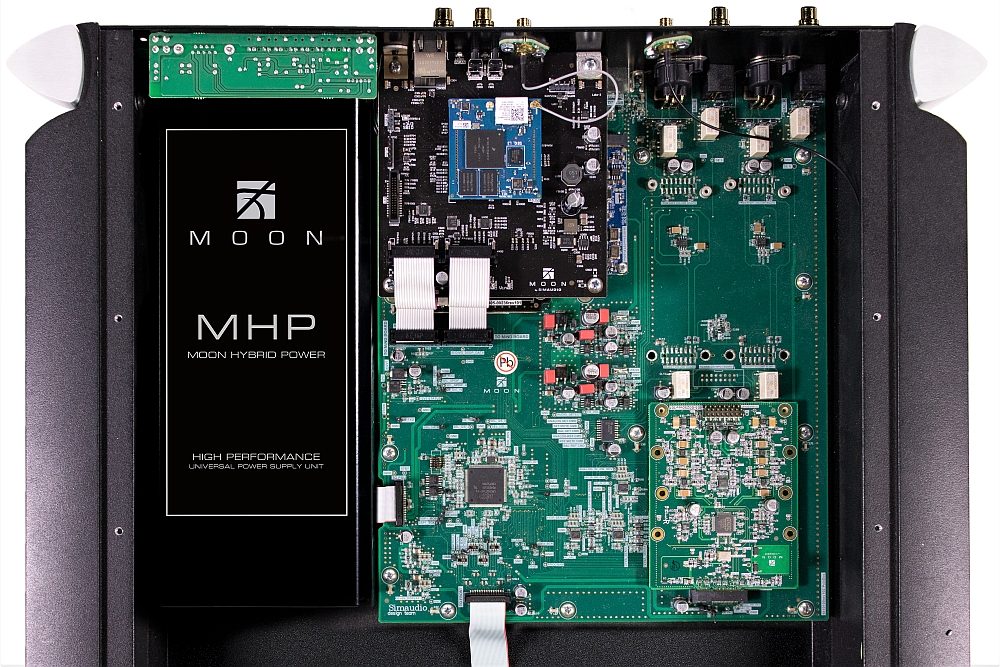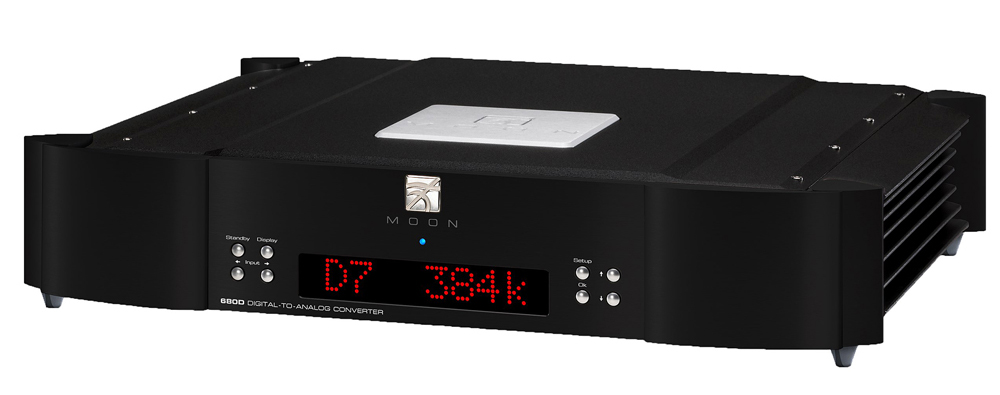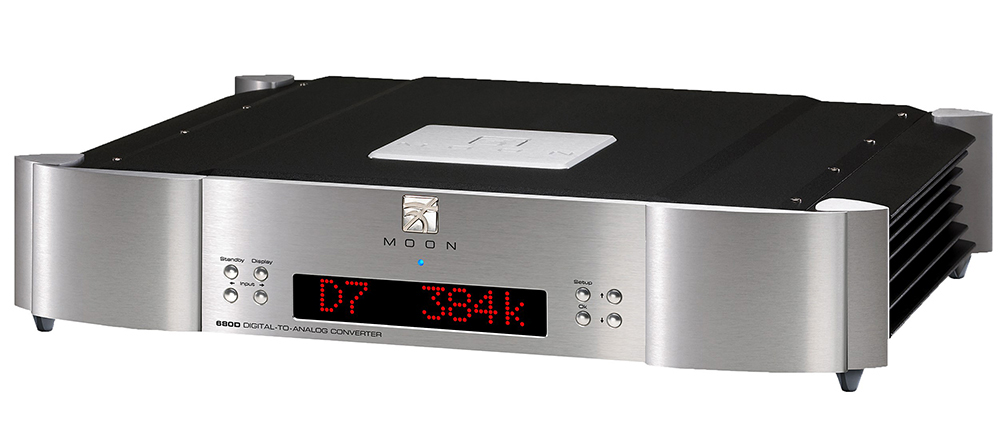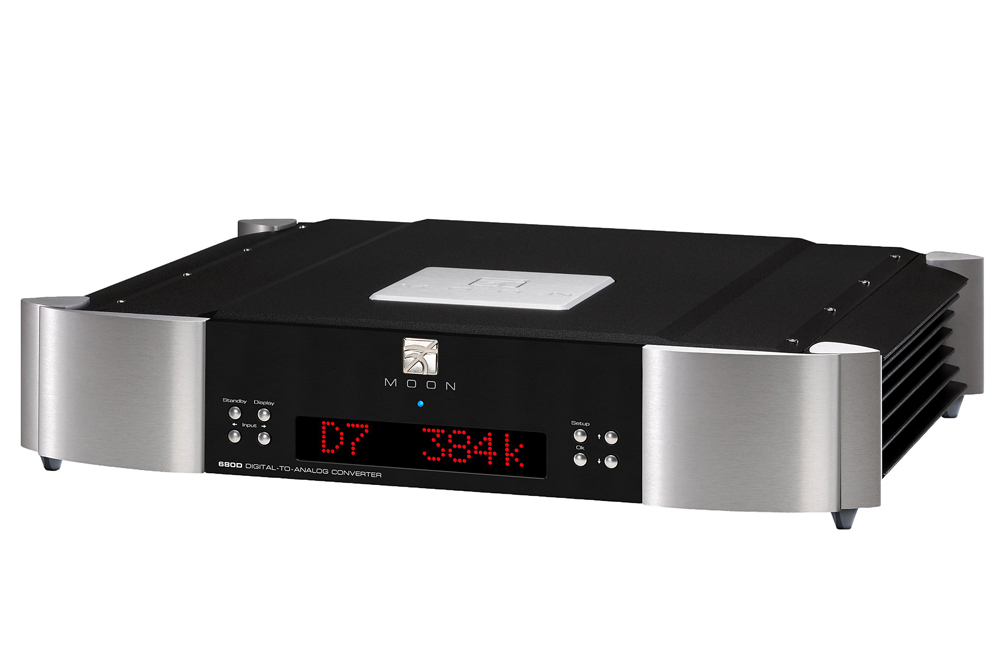What do you want from your audio gear? Usability and convenience? An absence of aggravation? Or supreme audio quality? The magic that can sometimes be realised in a fine stereo system? Sometimes these two considerations can be at odds. But not, it seems, with Canadian Hi-Fi maker Simaudio. I’ve now put two of its Moon-branded products through their paces and both have been glorious in their acoustic performance while being delights to use. The first was merely a straightforward DAC. But achieving similar effectiveness in a combined DAC and Network Streamer is a harder ask. Yet the Moon 680D has achieved just that.
What is the Moon 680D?
Simaudio calls the Moon 680D a ‘Streaming DAC’. It has nine digital “inputs”, of which seven are in fact for the “DAC” part of the name. The other two are for streaming network audio and for Bluetooth.
You can use the Moon 680D as a DAC for your CD transport and for some other network streaming device – so long as it has a digital output. And you can used it with a professional audio source of some kind. The first of the digital audio inputs is a 3-pin XLR supporting the AES/EBU digital audio standards used in studios. Numbers two and three are standard consumer-level S/PDIF RCA inputs, while the fourth is also S/PDIF, but uses a BNC socket. Five and six are Toslink – optical digital audio inputs. Number seven is a USB Type-B socket into which you can plug a computer for an asynchronous digital audio connection using USB Audio Class 2.0 protocols.
My main interest was input number 8. This is the streaming audio input. I will return to it shortly, but first I must round things up by mentioning input number 9. That’s Bluetooth. The quality above standard Bluetooth is modestly improved by its support for the aptX codec (but not for aptX HD). Of course, to take advantage of aptX your phone or tablet will also have to support aptX. That rules out Apple devices. There’s no mention of support for AAC, which is slightly better than default Bluetooth codec SBC, and which is supported by Apple devices. My Android phone does indeed support aptX (and aptX HD), and it reported that its connection with the Moon 680D used standard aptX. It is good that even high-end audio devices such as the Moon 680D support Bluetooth. Not for any kind of critical listening, but it does offer a nice convenience for visitors and such.
So back to input number 8. It took me a moment to realise that I shouldn’t be looking for any special “streaming” function. You see, the Moon 680D has been designed entirely as a nine-input DAC. But it houses internally a separate Bluetooth receiver (with a short, dedicated antenna on the rear) and a separate network streaming module.

This streaming module is called MiND2. The Moon MiND2 network player is available as a separate unit in its own box, priced in Australia at around $2,500. It can be connected to your network via Ethernet – that is, by standard network cable – or by Wi-Fi. Its capabilities are best used with the MiND app. Apparently, it supports clever things like multi-room audio with other Moon devices, but that’s something I did not explore, not having any to hand.
So, what can this MiND2 network streamer handle?
It can play audio from:
- TuneIn – thousands of radio stations from around the world and podcasts,
- Streaming internet music from Deezer, HIGHRESAUDIO, Qobux and TIDAL,
- The device on which you’re running the MiND app – iOS or Android, and
- Music streamed from UPnP music servers on your network.
It supports MQA both from music streamed via UPnP and, at least, TIDAL. And it supports ROON, should you wish to use that service to manage all your digital audio media and streams. I checked that I could stream music from my Android and iOS devices, but otherwise I used the Moon 680D with TIDAL and the terabyte or so of music on my Synology network attached storage.
And what sort of digital audio signals? PCM of 16, 24 or 32 bits and from 44.1kHz to 384kHz sampling. And DSD64, DSD128 and DSD256. Before going further, I may as well say here that I confirmed that all the DSD standards, and the PCM for 16 and 24 bits, worked using both the MiND2 streaming input and Input 7, a direct connection with one of my computers. Likewise for MQA.
Indeed, as I’m writing the Moon 680D is playing a Carl Nielsen Chaconne encoded in MQA and employing the ‘Studio’ MQA flag. It is apparently 44.1kHz encoded, nonetheless. But when I’ve streamed some ‘Master’ content from TIDAL, for example certain albums from the group Rush, the app has indicated up to 192kHz audio folded into the stream.
So, what can’t the Moon 680D handle? Well, first, in the continued mild deprecation of Apple (remember, no AAC for Bluetooth) it does not support streaming via Apple AirPlay. Not too much of a problem, I’d have thought. Just put the MiND app on your iPhone or iPad and you can stream its contents that way. Unless you use Spotify. The Moon 680D does not support Spotify Connect. Nor Chromecast. And since the MiND app doesn’t offer Spotify, you can’t use that service.
You don’t have to use the MiND app for streaming UPnP music. I also successfully used my favourite, BubbleUPnP on Android, to stream music from my server to the Moon 680D. With quite a few streaming devices I prefer BubbleUPnP to the specific product app. But with the Moon 680D, I liked the MiND app a lot better for several reasons. It worked with perfect reliability. And that’s a rare feature in a streaming product’s app. It provided gapless playback instantly with no special settings. I use the opening two tracks on Bela Fleck and the Flecktone’s album Hidden Land to check this. There was absolutely no audible glitch as track one was finished and track two began. It also provided playlists agnostic as to source. I could set an album from TIDAL to play and then add to the end an album or a track from my server, then another album or track from TIDAL. It’s up to you. Develop a favourite sequence of music and you can save the playlist.
Look, I’ve used apps from some of the biggest names in the business which have left me just about tearing my hair out. The MiND app is pretty much perfect in its reliability, and highly usable in its layout. I tried it on iPad and iPhone and Android phone and tablet and it worked well on all. The layout worked better with a bigger screen, so for the most part I used an iPad.
Let’s return to the hardware. Moon devices seem to come in two basic design modes. The regular mid-level devices tend to be plain in styling with black facia. The high-end and super high-end models – for example, the AU$200,000+ Moon 888 power amplifier – feature brushed aluminium corner pieces and heavily fluted horizontal heatsinks along the sides. The Moon 680D is styled in that manner. There are eight control buttons on the front and a substantial machined aluminium remote control lets you run proceedings at a distance. Quite a distance.

The slightly old-fashioned front panel display uses a red dot-matrix system. No squinting required, even from across the room. The characters on the display are close to two centimetres tall. It shows the input selected and the audio format. Typically that’s the sampling frequency but for DSD it shows DSD, DSD2 or DSD4, the latter two for 2x (DSD128) and 4x (DSD256). If you’re streaming MQA, that’s what it shows. Or if it’s authenticated MQA, a dot is placed after MQA. Track titles and such are not shown. If you’re really interested in details, go back to the app.
Output is via your choice of RCA or balanced XLR. By balanced XLR, Moon means balanced. I attended a presentation in Athens earlier this year (before the troubles commenced) by Simaudio (disclosure: the Australian distributor BusiSoft AV sponsored travel and accommodation). Among other things, the presenter was at pains to stress that “balanced” means more than simply XLR connections. The circuitry throughout uses a balanced push-pull configuration.
Specifications? Well, yes, there are some. Moon is a company that’s mostly about how stuff sounds, but it also insists on exemplary figures. The various distortion measures feature three zeros after the decimal point. All leakage and noise levels are at -120dB or better. The unit weighs the better part of 20kg. For a further overview of the 680D Moon has posted a You Tube video here.
Listening
What makes for a truly enjoyable listening session? We writers in this field talk almost entirely about certain intrinsic qualities – or otherwise! – in the equipment that we’re reviewing. But there’s much more to it than that. Everyone knows that the listening room has a huge effect on sound, which is why we all try to review in our own consistent environment. Likewise for the associated equipment which we list at the foot of our reviews. But what about our mood? That is, my mood as I’m listening?
Seriously, there is little in life that is more subjective than the enjoyment of music. Come into it with a sour mood and usually there’s not much to be enjoyed. And guess what? A great generator of negative feeling is equipment that doesn’t work the way it is supposed to. My user experience with the Moon 680D was easily the most relaxing I’ve ever had with a network audio player. Note, as recommended by the manual, I used an Ethernet connection rather than Wi-Fi, even though it supports the latter. High bitrate audio – such as DSD256 – can exceed the limits of Wi-Fi data rates in the real world. That’s another aggravation to be avoided. If you’re spending a big chunk of change on this unit (AU$15K), you can surely stretch to an extra Ethernet connection and a bit of cable.
Circumstances were kind to me with this review. I got to spend about three weeks with the Moon 680D. In those weeks I used it for several hours every day. In all that time it misbehaved precisely zero times. That is unprecedented in the stuff I’ve reviewed – and I’ve reviewed perhaps a dozen network streamers for a number of publications. As the days progressed, I approached my music listening – or just firing it up for background while I was working on other stuff – with a pleasing equanimity. It was clear that it would work, and work it did. No hassles.

That left me predisposed to simply enjoy the music it delivered. I must now confess to having lately fallen in love with something so mainstream pop that it won just about everything in the most recent Grammy awards. That’s Billie Eilish’s album When We Fall Asleep, Where Do We Go? Aside from fascinating music, it appeals to my prejudices about album production. This was produced by Eilish’s brother in, as Wikipedia terms it, “his small bedroom studio”. Actual major studio production tends to homogenise sound. This one is produced idiosyncratically, with life and a wonderful mixture of high-level processing and naturalness. In “Bury a Friend” Eilish’s voice swings and fades from electronic manipulation into clean, almost unprocessed clarity. And it was that which the Moon 680D delivered, without effort. The powerful bass throughout the album including the bass modulated voice on “xanny” – it wasn’t just modulating the voice, but the modulation tone came through as well – shook my couch (and me, just a little). Yet, all the little details captured in the slightly naïve recording come through as well. The sound is multilayered, not only in the musical sense but also in the sense of stage depth. The Moon streamer layered this stuff to perfection.
Enough of recent stuff. How about the Finale of the Schedrin ballet version of Bizet’s Carmen, delivered by Yuli Turovsky directing the I Musici De Montreal. This percussion-heavy version (Schedrin lucked out in making it past the Soviet censors) was delivered by the Moon streamer with zero dynamic compression – vital for this music – but also a first-class realisation of fine detail within the stream. In particular the tympani, playing quietly but vitally, underneath the main percussive elements, came through with a superbly natural feel.
Returning to naïve bedroom productions, “Holiday” from George’s 2000 EP Bastard Son/Holiday should have been a worldwide hit, showcasing Katie Noonan’s astonishing voice. She was there in my listening room. Right there. As was the band around her – a largely virtual band I think. The cymbals danced around her head as she sang. The vocal clicks into the microphone came through intact – naïve recording, remember. Everything in the recording was there.
How about something a bit out there. “The Carpenter and the Dainty Bride” from Primus’ Animals Should Not Act Like People is, like most of Primus’ other music, a Hi-Fi-demo tour de force. The different elements of the drum kit were properly layered by the Moon 680D, while tiny almost-hidden acoustic touches hovered properly at the fringes of the mix. The result? Perfect.

Going back in time a little, Blood, Sweat & Tears’ “I Love You More Than You’ll Ever Know” from Child is Father to the Man kind of astonished me. The drum kit, distant at about ninety per cent to the right, simply emphasised the rounded, three-dimensional nature of every element of the music. It was magic.
Further back? How about to 1959? “Love Me or Leave Me” from the 2013 remastered stereo version of Nina Simone’s debut album Little Girl Blue is, due to the nature of the technology at the time, also a naïve recording. Little to nil processing. Live in all ways other than the presence of an audience. Again, the Moon 680D simply absented itself from the whole process. It was transparent. It was invisible. It was glorious in its absence.
Conclusion
I review a lot of gear and most of the time I’m pleased when the review period has expired, I’ve packed the device up and the courier has taken it away. But this time I mourned the departure of the Simaudio Moon 680D player. I suspect it’s going to be quite a while before I again get to enjoy such a fine combination of audio performance and practical design.
… Stephen Dawson
Associated Equipment
- Speakers — VAF Research Signature I93, VAF Research Signature I91, KEF LS50, Krix Seismix 1 subwoofer, Paradigm Servo 15 subwoofer
- Amplifier — Schitt Audio Vidar, Marantz MA700 monoblocks
- Preamplifier — Schitt Audio Saga S
- Sources — Digital: Denon DNP-730AE network streamer, Pro-Ject Audio Pre Box S2 DAC/headphone amp, Microsoft Surface Pro 6, HP Elitebook 840 G3, several Oppo DVD, BD and UHD players with support for DVD Audio and SACD Analogue: Rega Planar 3 turntable, Rega Exact MM cartridge, Rega Neo turntable PSU, NAD PP2 MM/MC phono pre-amp, Rega Fono Mini A2D MM phono preamp/ADC
- Cables — Interconnects personal DIY twin-core shielded microphone cable with Interdyn-branded gold-plated RCA plugs, Lenehan Audio pure copper ribbon speaker cables
- Audio Rack — Personally-made cabinets using 16mm MDF, screws and glue. Ugly as sin but very solid
- Miscellaneous — Listening room 6.5 metres by 5.1 metres by 2.4 metres. Sound absorbent foam on full wall behind speakers. Uneven surfaces on side walls
Simaudio Moon 680D Network Player/DAC
Price: AU$15,000
Warranty: 10 Years
Australian Distributor: BusiSoft AV
+61 3 9810 2900
www.busisoft.com.au
Simaudio Ltd
1345 Newton Road
Boucherville, Quebec, J4B 5H2
CANADA
+1 450 449 2212
www.simaudio.com












